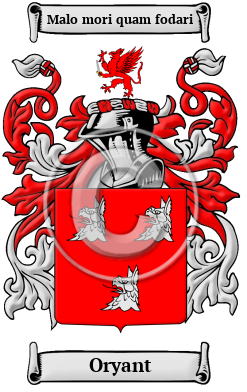| ![Show Contents]() Oryant History, Family Crest & Coats of Arms Oryant History, Family Crest & Coats of Arms
- Origins Available:
Ireland
Etymology of OryantWhat does the name Oryant mean? Today's Irish surnames are underpinned by a multitude of rich histories. The name Oryant originally appeared in Gaelic as Ó Maoilriain, formerly Mulryan, but now abbreviated to Ó Riain. 1 Early Origins of the Oryant familyThe surname Oryant was first found in County Tipperary (Irish: Thiobraid Árann), established in the 13th century in South-central Ireland, in the province of Munster. 1 According to O'Hart, the family claim descent from the Heremon Kings of Ireland through the MacMorough pedigree, specifically Cormac, brother of Eoghan who was ancestor of O'Righin; anglicized Mulrain, O'Ryan, Ryan and Ryne. (O'Hart) However, MacLysaght claims the family claim descent from O Maoilriain located in Owney, formerly called Owney O'Mulryan which forms two modern baronies on the borders of Limerick and Tipperary. 2 As both authorities were Chief Heralds of Ireland in their own time, we must leave the reader to ponder which of the two is more likely. Early History of the Oryant familyThis web page shows only a small excerpt of our Oryant research. Another 131 words (9 lines of text) covering the years 1694, 1709, 1732 and 1760 are included under the topic Early Oryant History in all our PDF Extended History products and printed products wherever possible. Oryant Spelling VariationsThe Middle Ages saw a great number of spelling variations for surnames common to the Irish landscape. One reason for these variations is the fact that surnames were not rigidly fixed by this period. The following variations for the name Oryant were encountered in the archives: O'Ryan, Ryan, Mulrian, Mulryan, O'Mulrian and many more. Early Notables of the Oryant familyFather Abraham Ryan, Poet; and Lacy Ryan (c. 1694-1760), English actor who appeared at the Haymarket Theatre about 1709. He was the son of a tailor, of descent presumedly Irish, was born in the parish of St. Margaret, Westminster, about 1694. On the...
Another 42 words (3 lines of text) are included under the topic Early Oryant Notables in all our PDF Extended History products and printed products wherever possible. Migration of the Oryant familyDeath and immigration greatly reduced Ireland's population in the 19th century. For the native Irish people poverty, hunger, and racial prejudice was common. Therefore, thousands left their homeland to seek opportunity in North America. Those who survived the journey and the quarantine camps to which they arrived, were instrumental towards building the strong developing nations of the United States and the future Canada. By far, the largest influx of Irish settlers occurred with Great Potato Famine during the late 1840s. These were employed as construction or factory workers. An examination of passenger and immigration lists has shown early immigrants bearing the name Oryant: Alexander, Alfred, Catherine, Cornelius, Daniel, Denis, Edward, Jeremiah, John, Margaret, Mathew, Michael, Patrick, Peter, Richard, Thomas, Timothy and William Ryan all arrived in Philadelphia between 1840 and 1860.
The motto was originally a war cry or slogan. Mottoes first began to be shown with arms in the 14th and 15th centuries, but were not in general use until the 17th century. Thus the oldest coats of arms generally do not include a motto. Mottoes seldom form part of the grant of arms: Under most heraldic authorities, a motto is an optional component of the coat of arms, and can be added to or changed at will; many families have chosen not to display a motto.
Motto: Malo mori quam fodari
Motto Translation: I would rather die than be disgraced.
- MacLysaght, Edward, The Surnames of Ireland. Ireland: Irish Academic Press, sixth edition, 1985. Print. (ISBN 0-7165-2366-3)
- MacLysaght, Edward, Irish Families Their Names, Arms and Origins 4th Edition. Dublin: Irish Academic, 1982. Print. (ISBN 0-7165-2364-7)
 |

